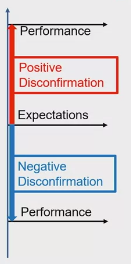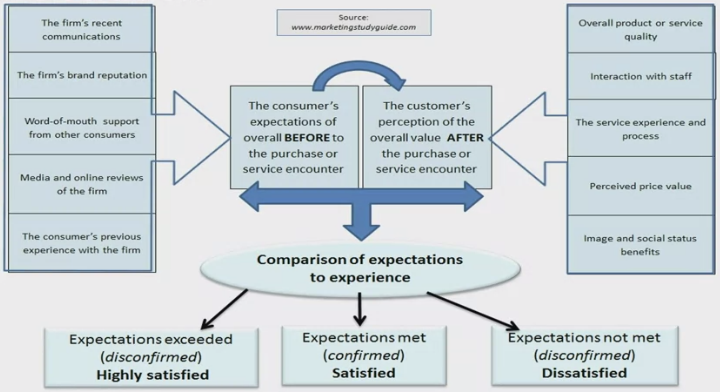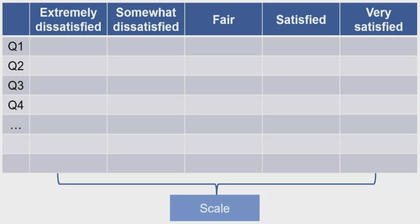Customer Satisfaction
Customer satisfaction is a measure of how products and services provided by a company meet or surpass customer expectations.
Why is it important?
This measure is important because it is an indicator of consumer purchase intentions and loyalty which means high customer satisfaction denotes delight of customers.
Disconfirmation Model
This model seeks to explain customer satisfaction. It is based on the comparison of customers’ expectations and their perceived performance ratings.
Why is it important?
This measure is important because it is an indicator of consumer purchase intentions and loyalty which means high customer satisfaction denotes delight of customers.
Disconfirmation Model
This model seeks to explain customer satisfaction. It is based on the comparison of customers’ expectations and their perceived performance ratings.

Expectations: customers' anticipation for product performance or service quality - what do they hope to get out of a product or service.
Performance: actual customers' perception of that product or service’s quality.
Disconfirmation: the gap between prior expectations and product performance. It can be positive or negative and it is generally measured on some sort of scale.
How do we evaluate the expectations of a customer and assessing their customer satisfaction?
Build a complaint system or suggestion system: Egs. Amazon’s feedback mechanism, MyStarbucks.com for Starbuck collects feedback.
Expectations: customers' anticipation for product performance or service quality - what do they hope to get out of a product or service.
Performance: actual customers' perception of that product or service’s quality.
Disconfirmation: the gap between prior expectations and product performance. It can be positive or negative and it is generally measured on some sort of scale.
How do we evaluate the expectations of a customer and assessing their customer satisfaction?
Build a complaint system or suggestion system: Egs. Amazon’s feedback mechanism, MyStarbucks.com for Starbuck collects feedback.
Ghost shopping method: Here, secret shoppers to go into a retail environment and pretend to be a shopper and ask questions and directions. This is to get an understanding of how clean the store is or level of service by the sales staff.
Critical incident method: This method looks at critical incidences or faults. This includes returns of a product and how often they're being returned and why they are being returned.
Customer satisfaction scale survey: Involves asking customers questions like, "On a scale of one to seven, are you happy with the product?"
Critical incident method: This method looks at critical incidences or faults. This includes returns of a product and how often they're being returned and why they are being returned.
Customer satisfaction scale survey: Involves asking customers questions like, "On a scale of one to seven, are you happy with the product?"
Customer satisfaction survey process
Purpose of the survey: Are you trying to get a handle on a new product and understand what the changes are and whether or not that is something that's desired, or are you looking at something they bought in the past, and are they likely to repeat purchase?
Sampling? This step looks at who the target audience is for a survey. For example, are you looking to understand perhaps maybe young teenage boys and their opinions on a product, or are you looking at new mothers, or are you looking at dads of teenagers?
Questionnaire: What should be asked? You don't want to burn the customer because their time is valuable. The questionnaire should be short and simple but at the same time, trying to get as much information as possible.
Analysis: once you have collected the data, you'll perform your analysis of the data and start to interpret the data and make conclusions.
Sampling? This step looks at who the target audience is for a survey. For example, are you looking to understand perhaps maybe young teenage boys and their opinions on a product, or are you looking at new mothers, or are you looking at dads of teenagers?
Questionnaire: What should be asked? You don't want to burn the customer because their time is valuable. The questionnaire should be short and simple but at the same time, trying to get as much information as possible.
Analysis: once you have collected the data, you'll perform your analysis of the data and start to interpret the data and make conclusions.
Simplified example of a questionnaire
Purpose of the survey: Are you trying to get a handle on a new product and understand what the changes are and whether or not that is something that's desired, or are you looking at something they bought in the past, and are they likely to repeat purchase?
Sampling? This step looks at who the target audience is for a survey. For example, are you looking to understand perhaps maybe young teenage boys and their opinions on a product, or are you looking at new mothers, or are you looking at dads of teenagers?
Questionnaire: What should be asked? You don't want to burn the customer because their time is valuable. The questionnaire should be short and simple but at the same time, trying to get as much information as possible.
Analysis: once you have collected the data, you'll perform your analysis of the data and start to interpret the data and make conclusions.
Sampling? This step looks at who the target audience is for a survey. For example, are you looking to understand perhaps maybe young teenage boys and their opinions on a product, or are you looking at new mothers, or are you looking at dads of teenagers?
Questionnaire: What should be asked? You don't want to burn the customer because their time is valuable. The questionnaire should be short and simple but at the same time, trying to get as much information as possible.
Analysis: once you have collected the data, you'll perform your analysis of the data and start to interpret the data and make conclusions.
Simplified example of a questionnaire
Measurement:
To measure customer satisfaction, we measure the following:
Finally, we can implement a linear regression model.
To measure customer satisfaction, we measure the following:
- Expectations: Customers are asked to recall the situation prior to purchase and what they expected beforehand. For example: A customer thought that a particular drink should be/will be sweet.
- Performance: Customers are asked for their evaluation of the product and/or service in order to get an understanding of how they felt about their decision. For example, the drink they bought is sweet. Thus, in this case, they are satisfied.
- Disconfirmation: During the consumption, customers’ expectations can be negatively or positively disconfirmed. The gaps are calculated based on the difference between performance and expectations.
Finally, we can implement a linear regression model.



